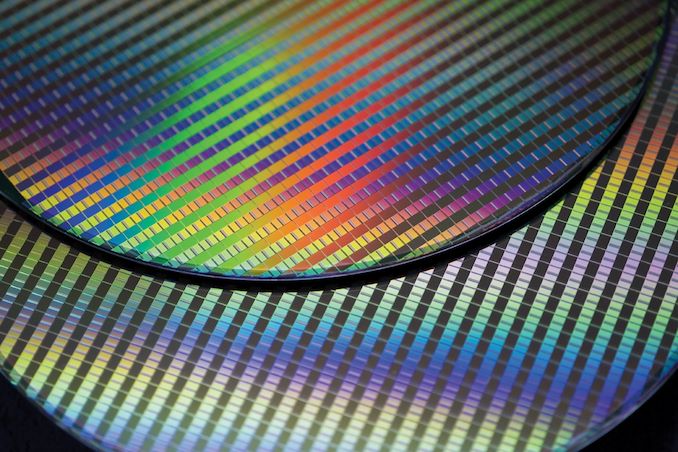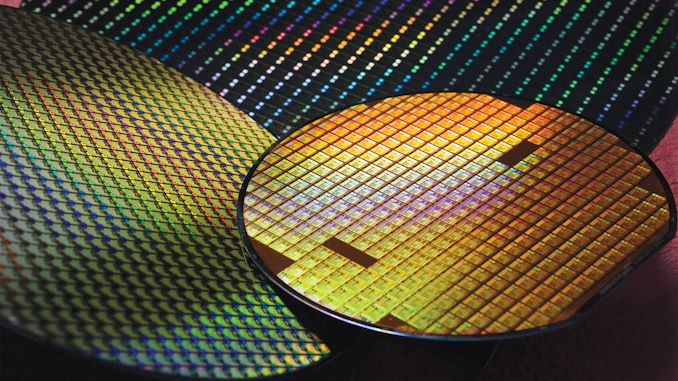As announced last week by TSMC, later this year the company is set to start high-volume manufacturing on its N3P fabrication process, and this will be the company’s most advanced node for a while. Next year things will get a bit more interesting as TSMC will have two process technologies that could actually compete against each other when they enter high-volume manufacturing (HVM) in the second half of 2025.
Advertised PPA Improvements of New Process Technologies
Data announced during conference calls, events, press briefings and press releases
Compiled
by
AnandTech
TSMC
N3
vs
N5
N3E
vs
N5
N3P
vs
N3E
N3X
vs
N3P
N2
vs
N3E
N2P
vs
N3E
N2P
vs
N2
A16
vs
N2P
Power
-25%
-30%
-34%
-5%
-10%
-7%***
-25%
-30%
-30%
-40%
-5%
-10%
-15%
-20%
Performance
+10%
+15%
+18%
+5%
+5%
Fmax @1.2V**
+10%
+15%
+15%
+20%
+5
+10%
+8%
+10%
Density*
?
1.3x
1.04x
1.10x***
1.15x
1.15x
?
1.07x
1.10x
HVM
Q4
2022
Q4
2023
H2
2024
H2
2025
H2
2025
H2
2026
H2
2026
H2
2026
*Chip density published by TSMC reflects ‘mixed’ chip density consisting of 50% logic, 30% SRAM, and 20% analog.
**At the same area.
***At the same speed.
The production nodes are N3X (3nm-class, extreme performance-focused) as well as N2 (2nm-class). TSMC says that when compared to N3P, chips made on N3X can either lower power consumption by 7% at the same frequency by lowering Vdd from 1.0V to 0.9V, increase performance by 5% at the same area, or increase transistor density by around 10% at the same frequency. Meanwhile, the key advantage of N3X compared to predecessors is its maximum voltage of 1.2V, which is important for ultra-high-performance applications, such as desktop or datacenter GPUs.
TSMC’s N2 will be TSMC’s first production node to use gate-all-around (GAA) nanosheet transistors and this will significantly enhance its performance, power, and area (PPA) characteristics. When compared to N3E, semiconductors produced on N3 can cut their power consumption by 25% – 30% (at the same transistor count and frequency), increase their performance by 10% – 15% (at the same transistor count and power), and increase transistor density by 15% (at the same speed and power).
While N2 will certainly be TSMC’s undisputed champ when it comes to power consumption and transistor density, N3X could possibly challenge it when it comes to performance, especially at high voltages. For many customers N3X will also have a benefit of using proven FinFET transistors, so N2 will not be automatically the best of TSMC’s nodes in the second half of 2025.
2026: N2P and A16
In the following year TSMC will again offer two nodes that are set to target generally similar smartphone and high-performance computing applications: N2P (performance-enhanced 2nm-class) and A16 (1.6nm-class with backside power delivery).
N2P is expected to deliver a 5% – 10% lower power (at the same speed and transistor count) or a 5% – 10% higher performance (at the same power and transistor count) compared to the original N2. Meanwhile, A16 is set to offer an up to 20% lower power (at the same speed and transistors), up to 10% higher performance (at the same power and transistors), and up to 10% higher transistor density compared to N2P.
Keeping in mind that A16 features enhanced backside power delivery network, it will likely be the node of choice for performance-minded chip designers. But of course, it will be more expensive to use A16 because of the backside power delivery, which requires additional process steps.


